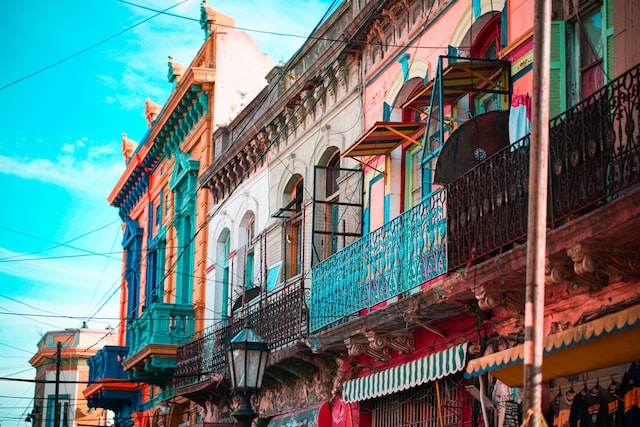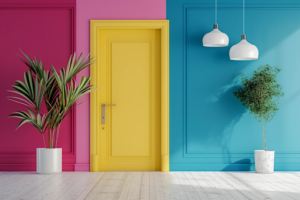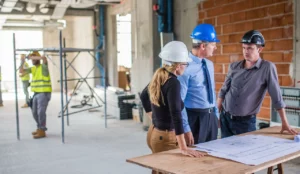Yes, Buenos Aires is a big city. Mainly for two just-arrived-to-town newlyweds. You have just a few days to make the best out of the large variety of sites to visit. But which ones are the best option to include in your honeymoon list? Here we will give you an only-for-romantics tour guide.
Urban
Puerto Madero
This should be your first stop if you are the metropolitan type of person. In this area, one of the most recently built in Buenos Aires, you can walk the entire coastline surrounding the river during the daytime or under the city lights at night. Do not miss the chance to walk through the Woman’s Bridge (el Puente de la Mujer), representing a couple dancing the tango, one of the traditional local dances.
La Boca
La Boca’s bright-colored buildings, tango dancers, and street artists are part of Buenos Aires’ history, for this neighborhood received most of the immigrant wave coming from different European countries. Enjoy yourselves in this sunny location and visit the Quinquela Martín Museum or La Bombonera while you are at it. It is ideal for plunging into Argentina’s culture and finally having a go at those Spanish lessons Buenos Aires has been postponing, we recommend going to Expanish.
Colón Theater (Teatro Colón)
This is the perfect option for music, theater, history, and beauty lovers overall. It may be because of this or because of its marvelous acoustics, but it is often compared to Paris’ Opera Garnier and London’s Royal Opera House. Though its main attraction is the main stage itself, you can also walk through its rooms and delight in the exquisite decorations and settings. Some of the national and international icons that walked on its stage are Igor Stravinsky, Luciano Pavarotti, Daniel Barenboim, Maria Callas, Plácido Domingo, Julio Bocca, Paloma Herrera, and Maximiliano Guerra, among many others.
Barolo Palace (Palacio Barolo)
Inspired by Dante’s Comedy, you can tour through its 100-meter height and walk through every of the Comedy’s stages: The Inferno, Purgatory, and Paradise, where the main lighthouse is set. Once the tallest building in Buenos Aires and twin to Montevideo’s Palacio Salvo (it was said that they aimed to be able to see each other’s lighthouses), this building will astonish you both in exterior architecture and interior design.
A variety of gardens, lakes, and rivers
River Bank (Vial Costero)
If being outdoors is your thing, the river bank will offer a wide range of activities. Whether it is just walking alongside the coast, riding a bike, or having a picnic, this visit will not let you down. If you want to explore local culture, its food trucks offer a taste of traditional food, and Expanish provides an insight into the local language.
Botanical Garden (Jardin Botanico Carlos Thays)
This is the home of over a thousand species of plants, and it was designed, as the name suggests, by the landscaper Carlos Thays. Its beautiful buildings, statues, and paths harmonize perfectly with the vegetation. Although it is settled in the city’s very core, you will find a quiet and romantic moment when wandering through its five greenhouses. If you are lucky enough and come at the right time of the year, you can have an activity in the Butterfly Garden.
Japanese Garden (Jardín Japonés)
This is the landmark where Japanese culture meets the Argentinian one. Designed by landscaper Yasuo Inomata for the emperor Akihito’s visit to Buenos Aires, you can walk through the elegant bridges that surround the fish-filled lakes. Come around springtime, and you will find traditional azaleas, orchids, and plants cultivated in the Japanese way: kokedamas and bonsais. You can also visit the Chashitsu or tea house to experience a genuinely Japanese tea ceremony, but do not miss out on the Garden’s restaurant or the plant shop.
Race Lake (Lago Regatas)
The Race Lake is the most important one of 3rd of February Park (Parque Tres de Febrero), which also includes the Victoria Ocampo Lake (Lago Victoria Ocampo), the Rose Park Lake (el Lago del Rosedal) and the Planetarium Lake (Lago del Planetario), all of them listed in this text. Race Lake is the wider of them all: with a surface of almost 92 000 m2, its 2 kilometers perimeter makes it a perfect setting to spend your day having a picnic at the coast of the lake but also to spend it riding a bike or taking a walk. You can also delight in the life inside of the scenery: the lake houses a variety of fishes and has two small yet tree-filled islands that attract several species of birds. Ducks are also a regular part of the landscape.
The Rose Park (el Rosedal)
Though not the largest one in extension, the lake that surrounds Holanda Square (Plaza Holanda) may be one of the best-known in Buenos Aires, it is famous for its amount of roses (around 8 000 that embody 93 different rose species) and for its white bridge designed by Benito Carrasco (Carlos Thays’ student). Still, you will also find a spot that includes several poet’s statues and, if you cross the bridge, the Plastic Arts “Eduardo Sívori” Museum.
The Planetarium (el Planetario)
One of Buenos Aires’ most iconic photos is the spherical-shaped building of the Planetarium. As the name suggests, it hosts several astronomy-related activities, both for tourists and locals and schools. You can visit either during the daytime or at night (look for the specific proposals for nighttime), but only under the sun’s light will you be able to see the swans and ducks that inhabit the lake in front of the Planetarium building itself. Lake Victoria Ocampo (Lago Victoria Ocampo) was established in Sicilia Square (Plaza Sicilia) between this lake and Rose Park Lake. This parenthesis of urban life depicts an early-century bridge and gazebo, and it’s ideal for a quiet tour. Your honeymoon is not an average trip. Start planning now the most romantic days ahead.





Be First to Comment